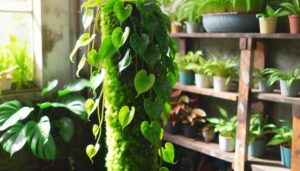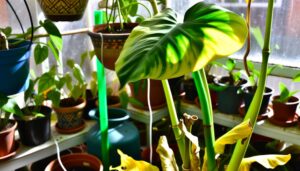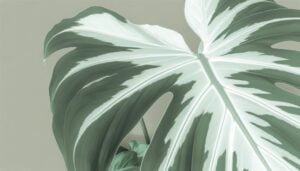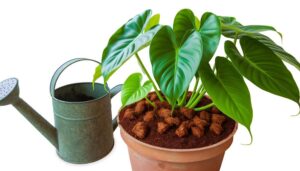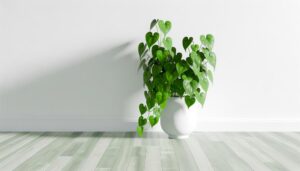What Is the Best Pot Size for a Philodendron Birkin?
Selecting the best pot size for a Philodendron Birkin is crucial for its growth and root health. Young plants thrive in pots with a 4-6 inch diameter, promoting proper aeration and drainage.
Mature Philodendrons require a pot that is 2 inches larger than the root ball to accommodate root expansion. Pots should have sufficient drainage holes to prevent waterlogged soil, which can lead to root rot.
Materials like terracotta are recommended for optimal oxygen flow. Observing signs of root binding, such as stunted growth and yellowing leaves, indicates it may be time to repot.
Discover expert insights on maintaining thriving Philodendron Birkins.
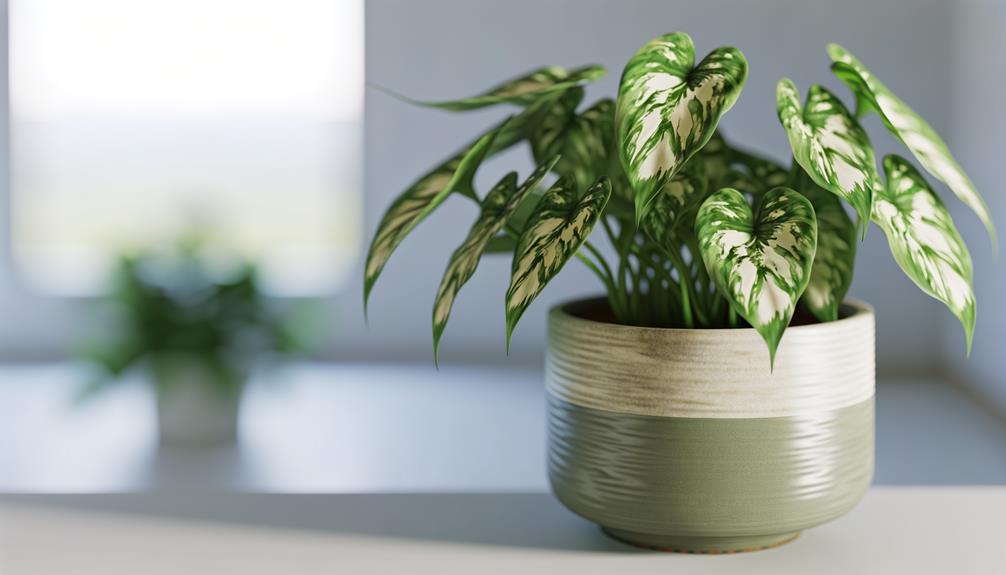
Key Takeaways
- Young Philodendron Birkin needs a pot diameter of 4-6 inches for proper drainage and aeration.
- Mature plants should be in a pot 2 inches larger than the root ball for adequate root development.
- Ensure the pot has drainage holes to maintain ideal moisture balance and prevent root rot.
- Choose breathable materials like terracotta for optimal oxygen flow.
- Repot every 1-2 years to accommodate growth and prevent root-bound conditions.
Understanding Philodendron Birkin Growth
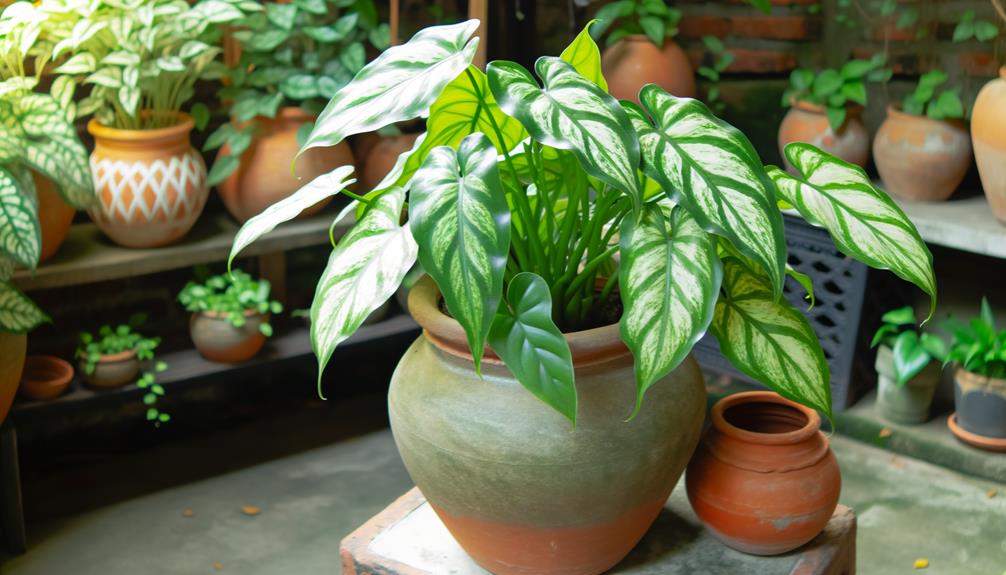
The growth dynamics of Philodendron Birkin are characterized by its moderate rate of development, influenced by factors such as light, temperature, and nutrient availability. Best growth occurs under bright, indirect light, with temperatures ranging between 65-80°F (18-27°C).
Nutrient uptake is critical; hence, a balanced, water-soluble fertilizer applied monthly supports foliage expansion. Philodendron Birkin exhibits a compact growth habit with its leaves unfurling into striking, variegated patterns. Root development is proportional to shoot growth, necessitating periodic evaluation of root-bound conditions.
Despite its moderate growth rate, environmental stressors such as low humidity and inadequate light can impede development. Understanding these factors is imperative for maintaining healthy growth and vigor in Philodendron Birkin, ensuring its aesthetic and structural integrity.
Importance of Choosing the Right Pot
Selecting a suitable container for Philodendron Birkin is essential to promoting ideal root health and overall plant well-being. The right pot ensures peak aeration, drainage, and space for root expansion, which are critical for nutrient uptake and water regulation.
Inadequate container size can lead to root bound conditions, stunted growth, and increased susceptibility to pathogens. Conversely, overly large containers may result in waterlogged soil, promoting root rot.
Materials such as terracotta offer breathability, while plastic retains moisture, impacting watering schedules. Drainage holes are imperative to prevent water accumulation.
Understanding the physiological needs of Philodendron Birkin, such as its preference for evenly moist but well-drained soil, informs the selection of an appropriately sized and material-specific container to foster robust growth.
Ideal Pot Size for Young Plants
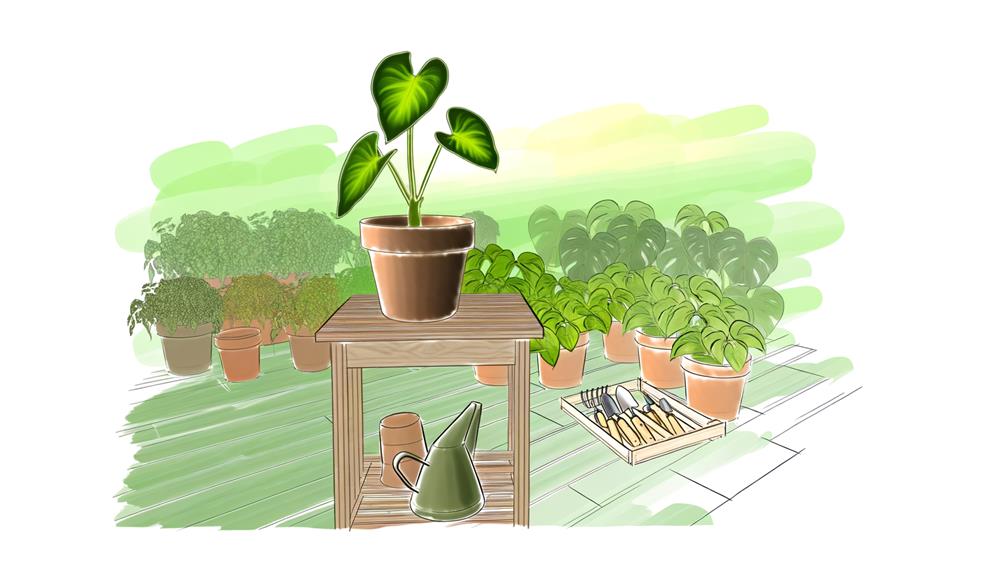
For young Philodendron Birkin plants, selecting an appropriate pot size is critical to guarantee adequate growth space requirements and best root system development.
A pot with a diameter of 4 to 6 inches typically suffices, promoting proper drainage and aeration essential for preventing root rot and supporting healthy growth.
Securing that the pot has sufficient drainage holes is vital for maintaining an ideal moisture balance within the soil.
Growth Space Requirements
Best growth for young Philodendron Birkin plants requires a pot size approximately 2 to 4 inches in diameter to guarantee sufficient root space and avoid waterlogging. Selecting an appropriately sized pot is critical for optimizing the plant's health and ensuring balanced moisture retention and oxygen flow to the roots. A smaller pot size mitigates the risk of over-watering, which can lead to root rot. Conversely, too small a pot may restrict root expansion, impeding overall growth.
| Pot Diameter (inches) | Plant Height (inches) |
|---|---|
| 2 | 3-5 |
| 3 | 6-8 |
| 4 | 9-12 |
| >4 | >12 |
Understanding these parameters allows for strategic pot selection, fostering robust Philodendron Birkin development during its early stages.
Root System Development
Understanding the best pot size for young Philodendron Birkin plants is important for promoting ideal root system development and preventing issues such as root bound conditions or inadequate moisture regulation. An ideal pot size allows for gradual root expansion, facilitating efficient nutrient absorption and overall plant health.
For young Philodendron Birkins, a pot with a diameter of 4-6 inches is recommended. This size provides sufficient space for initial root growth while avoiding excess soil that can lead to waterlogging and root rot. Selecting a pot that is only slightly larger than the root ball ensures that the roots can establish themselves without encountering barriers, thereby promoting robust root architecture and enhancing the plant's resilience and growth potential.
Drainage and Aeration
Proper drainage and aeration are key factors in selecting the ideal pot size for young Philodendron Birkin plants, as they directly influence root health and overall plant health.
A pot size that is too large can accumulate excessive moisture, leading to root rot, while a pot size that is too small restricts root expansion and nutrient uptake.
Best aeration is facilitated by selecting well-draining potting mixes and pots with adequate drainage holes. Young Philodendron Birkins typically thrive in pots ranging from 4 to 6 inches in diameter, which balances moisture retention and allows sufficient air circulation.
Ensuring these parameters prevents waterlogging and promotes a robust root system, thereby fostering healthy growth and energy in young plants.
Pot Size for Mature Philodendrons
Selecting the best pot size for mature Philodendron Birkin plants is important to guarantee adequate root development and overall plant health. Mature Philodendrons typically require pots that provide sufficient space without causing root crowding or waterlogging. Ideal pot size plays an essential role in maintaining the balance between root aeration and moisture retention.
Key considerations include:
- Diameter: A pot with a diameter 2 inches larger than the current root ball ensures proper growth.
- Depth: Depth should accommodate root expansion while preventing water stagnation.
- Material: Choose breathable materials like terracotta to enhance oxygen flow.
- Drainage: Ensure the pot has sufficient drainage holes to prevent root rot.
Careful selection based on these criteria will support robust growth and longevity of the Philodendron Birkin.
Signs Your Plant Needs Repotting
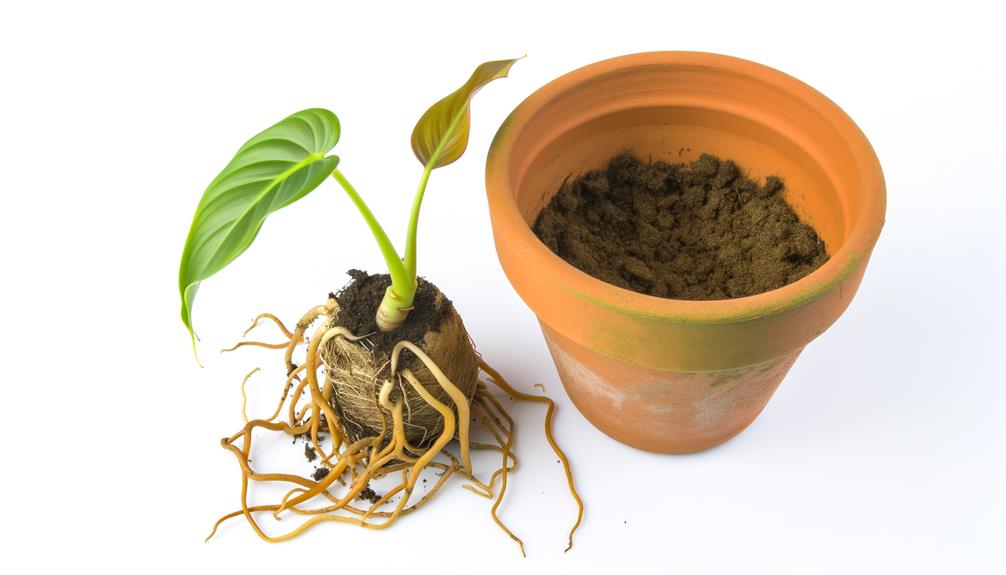
Frequent observation of root circling at the pot's surface or emerging through drainage holes indicates that a Philodendron Birkin may need repotting. Additional signs include stunted growth, yellowing leaves, and rapid wilting despite adequate watering. These symptoms suggest that the roots are compressed, limiting nutrient uptake and water absorption.
Moreover, the presence of a dense root ball, which often displaces soil, can lead to poor aeration and drainage, exacerbating plant stress. It is crucial to monitor these indicators closely, as prolonged root confinement can compromise the plant's well-being.
Repotting into a slightly larger container, typically 1-2 inches wider in diameter, ensures continued growth and health, facilitating proper root expansion and nutrient assimilation.
Drainage and Pot Material
The selection of suitable drainage and pot material is essential for maintaining ideal root health and preventing waterlogging in Philodendron Birkin plants. Appropriate drainage is necessary to avoid root rot, a common issue caused by waterlogged soil.
Pot material also greatly influences moisture retention and aeration. For best health:
- Terracotta pots: Porous, encouraging air exchange and reducing excess moisture.
- Plastic pots: Lightweight, retaining moisture longer but requiring more attentive drainage management.
- Ceramic pots with drainage holes: Decorative and efficient in managing moisture levels.
- Self-watering pots: Beneficial for consistent moisture but must be monitored to prevent overwatering.
Common Mistakes to Avoid
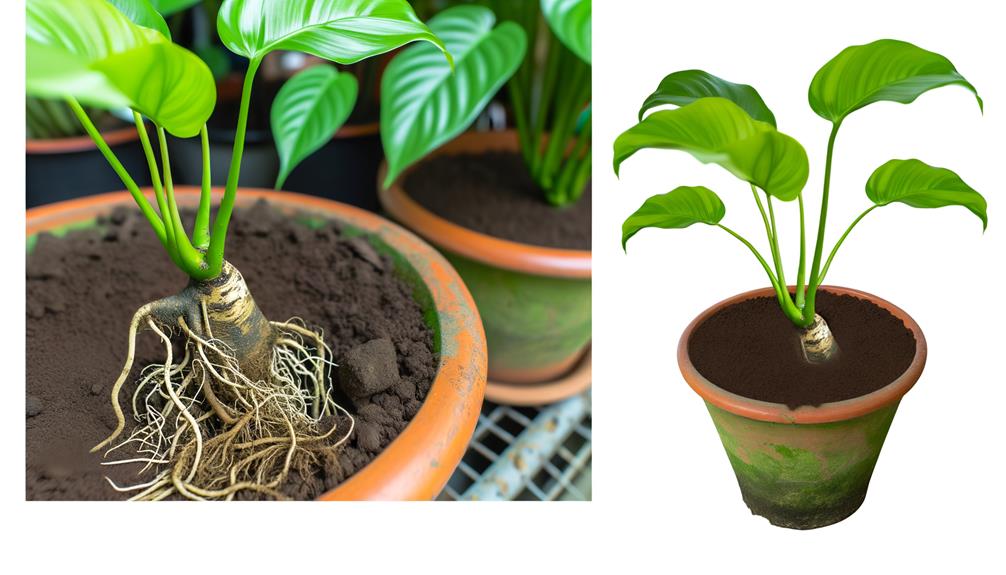
When selecting a pot for a Philodendron Birkin, it is important to avoid common pitfalls that could compromise its health.
Overwatering risks are exacerbated by using excessively large pots, leading to root rot.
Additionally, improper pot sizing can either restrict root development, causing stunted growth, or result in the plant becoming root-bound, thereby impeding nutrient uptake and overall health.
Overwatering From Large Pots
Utilizing oversized pots can significantly increase the risk of overwatering, leading to root rot and other water-related issues in Philodendron Birkin plants. Large pots retain more water due to their substantial soil volume, which can remain saturated for extended periods. This persistent moisture creates an anaerobic environment detrimental to root health. Consequently, the roots may suffocate, decay, and impair the plant's overall essentiality.
To mitigate these risks, consider the following factors:
- Drainage Efficiency: Make sure the pot has adequate drainage holes to facilitate water flow.
- Soil Type: Use well-draining soil to prevent water accumulation.
- Watering Frequency: Adjust watering schedules to account for slower soil drying times.
- Pot Size: Select a pot size proportionate to the plant's root system.
Stunted Growth Issues
One prevalent mistake leading to stunted development in Philodendron Birkin plants is the use of pots that are too small, limiting root expansion and nutrient absorption. Such confinement can lead to restricted access to necessary minerals and water, ultimately causing subpar overall plant health. Best pot size guarantees ample space for root growth and improved air circulation. Additionally, inadequate pot size can worsen water retention issues, resulting in root decay and further stunted development.
| Emotion | Cause | Solution |
|---|---|---|
| Frustration | Slow development due to restricted root space | Choose a pot that allows root expansion |
| Concern | Yellowing leaves from nutrient deficiency | Ensure appropriate pot size for nutrient uptake |
| Disappointment | Poor plant health and aesthetics | Repot regularly to accommodate growth |
Understanding these factors is essential for cultivating a flourishing Philodendron Birkin.
Root Bound Problems
Root bound conditions in Philodendron Birkin, characterized by tightly packed roots that encircle the pot's interior, are a common issue that hinders plant health and growth. Such conditions lead to several adverse effects, including nutrient deficiency, water stress, and stunted growth. It is essential to recognize and address these issues promptly to maintain plant vigor.
To avoid root bound problems, consider the following:
- Periodic repotting: Repot every 1-2 years to guarantee adequate space for root expansion.
- Root pruning: Trim overgrown roots to stimulate healthier growth.
- Pot size: Select a pot that is 1-2 inches larger in diameter than the current one.
- Soil quality: Use well-draining soil to prevent waterlogging and root rot.
Adhering to these practices ensures ideal growth conditions for your Philodendron Birkin.
Seasonal Pot Size Adjustments
Adjusting the pot size of a Philodendron Birkin seasonally maximizes root health and growth by accommodating the plant's varying nutrient and moisture requirements throughout the year.
During the spring and summer, the plant undergoes active growth phases, necessitating a larger pot to facilitate adequate root expansion and efficient nutrient uptake.
Conversely, in fall and winter, the plant's growth rate diminishes, reducing its water and nutrient needs. Temporarily transferring the plant to a smaller pot during these dormant periods can prevent overwatering and root rot.
Seasonal pot adjustments ensure ideal aeration, prevent root compaction, and promote overall plant vigor by aligning the pot size with the Philodendron Birkin's physiological changes across different growth cycles.
Expert Tips for Optimal Growth
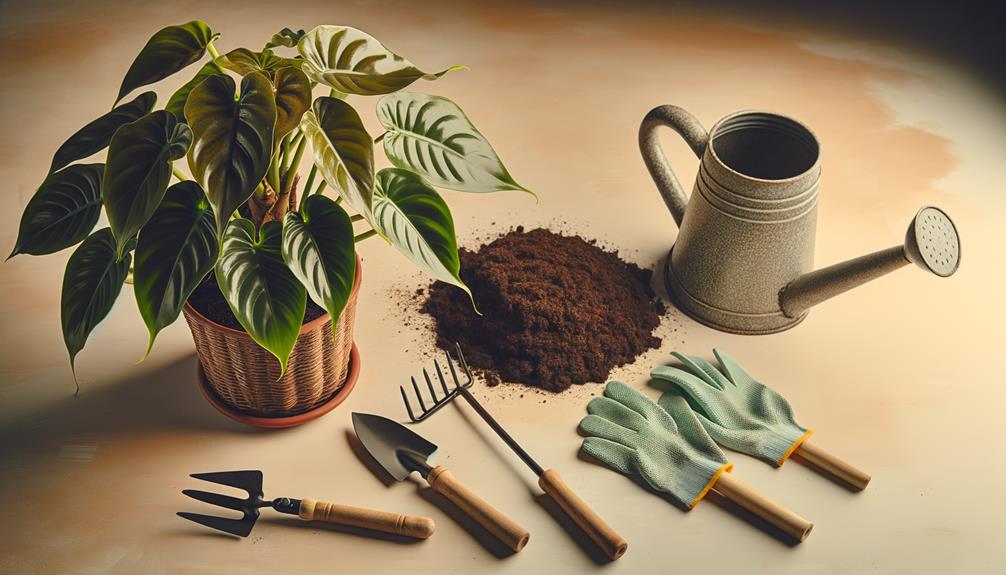
To achieve optimum growth for a Philodendron Birkin, it is essential to take into account factors such as precise light exposure, controlled humidity levels, and a balanced nutrient regimen. Ensuring ideal growth conditions requires meticulous attention to detail. Below are key considerations for enhancing growth:
- Light Exposure: Position in bright, indirect light to avoid leaf scorch while promoting photosynthesis.
- Humidity: Maintain humidity levels between 60-70% to mimic tropical conditions essential for leaf health.
- Soil Composition: Utilize a well-draining potting mix incorporating perlite and peat moss to prevent root rot.
- Nutrient Regimen: Apply a balanced, water-soluble fertilizer every 4-6 weeks during the growing season to support robust development.
Adherence to these guidelines will guarantee the Philodendron Birkin thrives.
Conclusion
Selecting the appropriate pot size for Philodendron Birkin is important to guarantee ideal growth, prevent root-bound conditions, and facilitate proper drainage. Young plants thrive in smaller pots, while mature specimens require larger containers.
Indicators for repotting include slowed growth and visible root crowding. Pot material and drainage features greatly impact plant health. Avoiding common mistakes and considering seasonal adjustments further contribute to successful cultivation.
Adhering to these guidelines promotes strong and healthy development in Philodendron Birkin.

